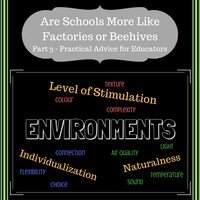
Practical Environmental Advice for Educators - Part 3
Today, research is pinpointing which aspects of the learning environment specifically affect learning. In their report titled Optimal Learning Spaces, Professor Peter Barrett and Dr. Yufan Zhang identify three broad principles along with their design parameters for schools: naturalness (light, sound, temperature, and air quality), individualization (choice, flexibility, and connection), and level of stimulation (complexity, color, and texture).1 Although there is much we still need to learn about the effects of each of these design parameters on learning, we can draw on this research and the metaphor of the beehive for guidance in optimizing learning environments now:
1. Create rich, varied, and stimulating learning spaces.
2. Designate spaces for whole class instruction, small group discussion and collaboration, active learning centers, as well as spaces for quiet reflection to create a balanced classroom.
3. Encourage cooperative learning and academic conversations by flexibly arranging desks or interlocking tables into clusters.
4. Encourage physical movement and the increased use of outdoor spaces.
5. Integrate technology and other resources flexibly.
6. Invite older students and community members into the class to share their expertise as mentors.
7. Enable students to take increasing responsibility for their own learning by posting daily tasks, sharing expected learning outcomes, and creating activity or learning centers.
8. Establish routines for storing materials, completed work, and classroom tools in clearly marked storage spaces to help students become more self-regulated.
9. Use classroom walls to display student work prominently along with posters that define spaces and clarify roles and expectations.
10. Allow natural light and the ability to look out of a window, wherever possible.
Notes
1. Barrett, P., & Zhang, Y. (2009). Optimal learning spaces: Design implications for primary schools. Salford, UK: University of Salford.
comments powered by Disqus

